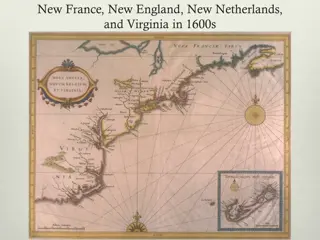Impact of North America's Physical Characteristics on Settlement Patterns
Physical characteristics such as landforms, bodies of water, climate, and natural resources in North America play a significant role in shaping settlement patterns. Major features like the Mississippi River System, Appalachian Mountains, Rocky Mountains, and Canadian Shield have influenced how and where people settle in the region. The diverse climates and locations of these features impact settlement decisions, with harsh environments posing challenges to human survival and development.
Download Presentation

Please find below an Image/Link to download the presentation.
The content on the website is provided AS IS for your information and personal use only. It may not be sold, licensed, or shared on other websites without obtaining consent from the author.If you encounter any issues during the download, it is possible that the publisher has removed the file from their server.
You are allowed to download the files provided on this website for personal or commercial use, subject to the condition that they are used lawfully. All files are the property of their respective owners.
The content on the website is provided AS IS for your information and personal use only. It may not be sold, licensed, or shared on other websites without obtaining consent from the author.
E N D
Presentation Transcript
World Geography North America
SSWG1. Explain why physical characteristics of place such as landforms, bodies of water, climate, and natural resources act as contributing factors to world settlement patterns. a. Identify and describe climates and locations of major physical features of North America. Explain how these physical characteristics impact settlement patterns including, but not limited to, the Mississippi River System, the Appalachian and Rocky Mountains, and the Canadian Shield.
Appalachian Mountains As the first American frontier, the Appalachians were a formidable challenge for settlers attempting to cross and settle to the west. With several peaks at over 6,500 feet, the Appalachians were an intense challenge, although the region had already been settled by American Indians. The Cumberland Gap is a pass through the mountains which offered a much more attainable route to the west. Rocky Mountains The Rocky Mountain chain begins in New Mexico and extends north through western Canada into Alaska. This massive mountain chain divides the continents watersheds and is a clearly divides most of western North America from the eastern two-thirds. Canadian Shield Much of the eastern half of Canada is part of the Canadian Shield. This area is characterized by the large amounts of igneous and metamorphic rock throughout the landscape. North American Climate The climate of North America is as diverse as its physical features. Combining the physical features and climate of an area, it s much easier to explain settlement patterns. The harsher the natural environment, both climate and physical landscape, the more difficult it is to thrive or even survive.























